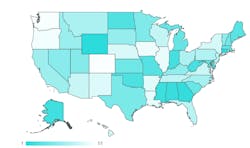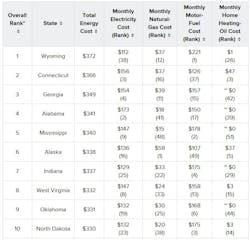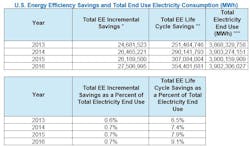When it comes to a recent widespread tendency on the part of journalists to complain about relatively higher per-capita energy costs in one region of the United States vs. another, utilities have become a victim of their own success. Why? Because a lot of the very same regions that are now complaining about their higher energy costs per capita do not see how critical highly reliable electric service was in increasing populations in those regions.
A review of local news outlets' responses to an interesting Wallethub study titled “2018’s Most & Least Energy-Expensive States” shows how underappreciated electric utilities remain.
State-by-state local reporting of the Wallethub story displayed a general lack of understanding of the central role played by electrification, in shaping U.S. population growth after WWII, and how the results affect per-capita energy usage to this day.
In his coverage of the July 2018 study, Wallethub’s financial writer, Adam McCann points out that “energy costs eat between 5 and 22 percent of families’ total after-tax income, with the poorest Americans, or 25 million households, paying the highest of that range.”
The Wallethub article goes on to state that “lower energy prices don’t necessarily equate to savings. Where we live and how much energy we use are a big part of the equation.
“For instance, although electricity is relatively cheaper in Southern Louisiana, its scorching summer heat raises costs for residents compared with the temperate climate in more energy-expensive Northern California, where heating and cooling units stay idle most of the year.”
The Atlanta Journal Constitution’s coverage of the Wallethub story was typical of some of the misunderstandings associated with this coverage. The AJC’s article focused on how Georgia compares to its geographic neighbors. And, like other coverage, the AJC also goes on to discuss similarly ranked states, and also displays some misunderstanding of how population distribution impacted the Wallethub study results.
The advent of air conditioning helped to spur population growth in hot, humid regions such as the metro Atlanta area, as well as helping to contribute to growth of suburbanization, both of which correlate strongly with the 2018 results of the Wallethub study, when it comes to the states with the highest overall per-capita energy costs.
Source: “2018’s Most & Least Energy-Expensive States” by Wallethub
Analogously, states with very low energy rankings in the Wallethub study, such as the state of New York, did not have the same sort of huge population growth spurts in the 1950s that one finds in states like Georgia. New York, and some of the states with lower per-capita annual energy usage, have tended to have higher portions of their populations in cities (rather than in higher per-capita energy usage found in suburbs).
But typical local coverage of the Wallethub study does not point out the role played by electrification in shaping where people live, and in shaping their overall energy footprints. For example, the AJC article asks why energy costs vary across the country, and, ignoring the great rating achieved by California in the study, makes reference to a quote of Brown University professor Matthew Turner who “told WalletHub that costs tend to be higher in states that mandate the use of renewable energy, which is cleaner and contributes less to global warming. Coal and gas-fired power cost about the same and gas fired power puts a tiny fraction of the poisonous soot into the atmosphere as coal, and around half the CO2, Turner said.”
Consider the components and rankings from the Wallethub study:
Take a look at Indiana, and then consider another recently published article in the trade media that displays a misunderstanding of energy efficiency program size and influence. The article states: “I have no idea why Indiana is in the top 10 at all…wait yes I do. It is because the utility companies defunded energy efficiency to the point of almost killing the program.”
The misunderstanding shown in the article becomes apparent when we consider what impact better Energy Efficiency programs could have had on the $129 spent annually by the typical electricity customer in Indiana. A recent ACEEE webinar provides a good perspective on the size and scale of Energy Efficiency program savings. At 17 minutes into the webinar, it is stated that leading utilities have been able to achieve net savings of 1.5% of electricity sales with their Energy Efficiency programs, with an exemplary utility achieving 3% savings.
Even if there were no cost to such EE programs, the result would only be a $4 reduction in the typical Indianan’s annual electric bill—insufficient to change their ranking. And in a similar way, the best indicators from EIA data on EE programs, per the table below, shows an annual incremental energy efficiency savings below 1%, and a cumulative savings of 10%. The 10% savings, which would take years to achieve, could move Indiana in a favorable direction only slightly, from 7th worst state to perhaps the 10th worst.
* Source: EIA Energy Efficiency and Total End Use Electricity Consumption (MWh)
** Source: EIA Energy Efficiency Life Cycle savings
*** Source: EIA Sales and Direct Use of Electricity to Ultimate Customers
Thinking back to the aforementioned tendency on the part of journalists to take utilities for granted, it makes sense to think about the word “utility” itself: The utility of a utility is in its utility. But is this sufficient cause to continue to allow our industry to be taken for granted? We should have regulators help fund programs, whether at the local, state, or national level, to go further in showing our customers how much our industry has done to positively shape the viability of so many of the places where we now live.
The original Wallethub story is at this link.





